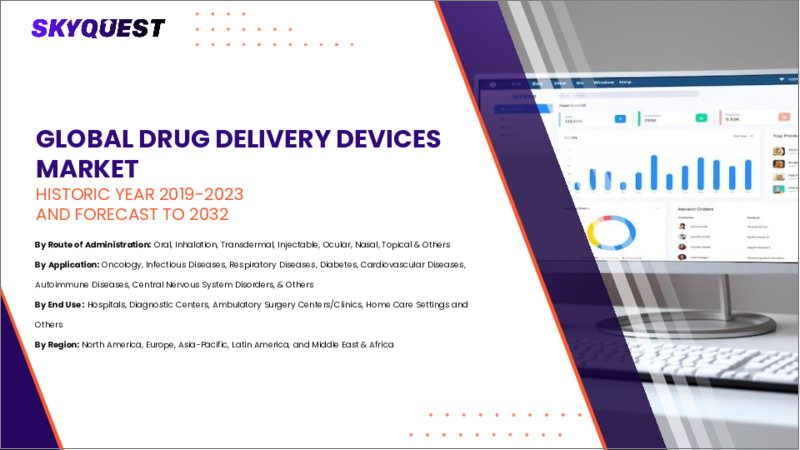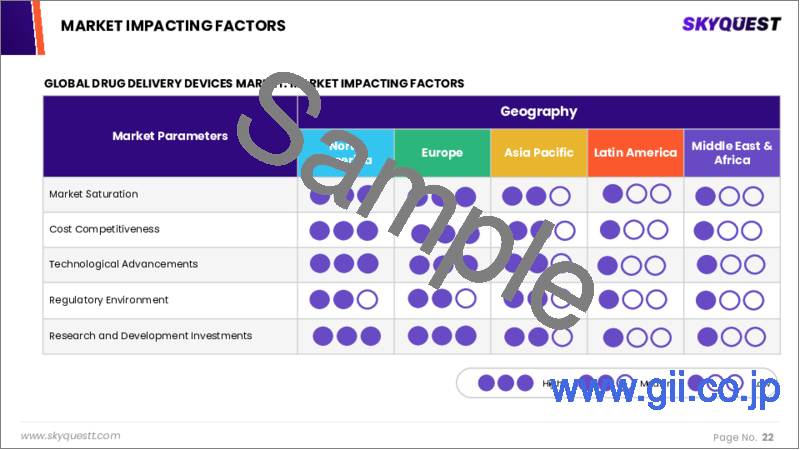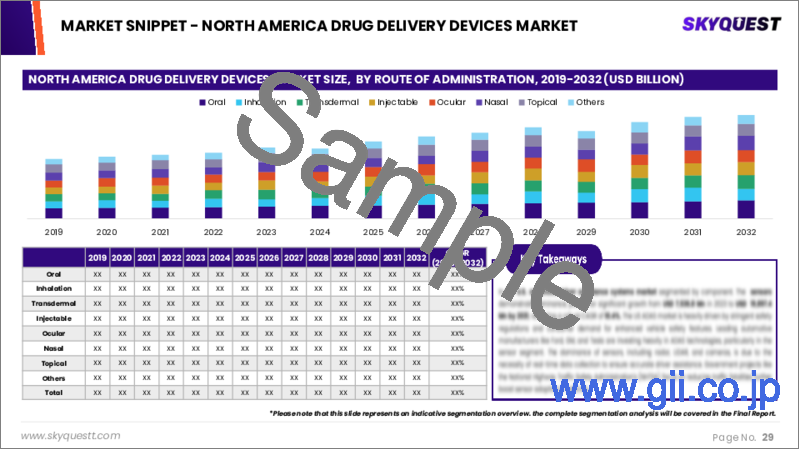|
|
市場調査レポート
商品コード
1596897
ドラッグデリバリーの市場規模、シェア、成長分析、投与経路別、用途別、最終用途別、地域別 - 産業予測、2024年~2031年Drug Delivery Devices Market Size, Share, Growth Analysis, By Route of Administration (Oral, Injectable), By Application (Oncology, Infectious Diseases), By End-use (Hospitals, Diagnostic Centers), By Region -Industry Forecast 2024-2031. |
||||||
|
|||||||
| ドラッグデリバリーの市場規模、シェア、成長分析、投与経路別、用途別、最終用途別、地域別 - 産業予測、2024年~2031年 |
|
出版日: 2024年11月20日
発行: SkyQuest
ページ情報: 英文 212 Pages
納期: 3~5営業日
|
全表示
- 概要
- 目次
ドラッグデリバリーの世界市場規模は、2022年に2,623億米ドルと評価され、2023年の2,777億8,000万米ドルから2031年には4,394億米ドルに成長し、予測期間中(2024年~2031年)のCAGRは5.90%で成長する見通しです。
ドラッグデリバリー市場は、治療薬の標的部位への正確な送達を促進し、治療効果を高める先進技術の採用が増加していることが背景にあり、大きな成長を遂げています。これらのデバイスは薬物投与を最適化し、投与量を最小限に抑え、潜在的な副作用を軽減するだけでなく、原薬の必要性を減らすことでコスト削減にも貢献します。新たなドラッグデリバリーソリューションに対する需要の高まりは、この分野における研究開発イニシアチブを後押ししており、現在進行中の研究では、デバイスへのアクセス性、精度、患者への利便性の向上に焦点が当てられています。業界各社は、次世代のドラッグデリバリーシステムを開発するため、革新的な技術の進歩を積極的に追求しています。さらに、バイオ医薬品セクターの急速な拡大が、さまざまな疾患に対する新たな治療薬の開発を刺激し、市場の成長ポテンシャルをさらに高めています。製薬企業による臨床試験への資金投資の増加と、FDAやEMAといった規制機関の支援的役割が相まって、ヘルスケア状況における革新的な薬剤やデリバリー手法の出現が促進されています。その結果、ドラッグデリバリーデバイス市場は、このような活発な環境のもと、継続的な進歩と最先端のソリューションの導入が期待されています。
目次
イントロダクション
- 調査の目的
- 調査範囲
- 定義
調査手法
- 情報調達
- 二次データと一次データの方法
- 市場規模予測
- 市場の前提条件と制限
エグゼクティブサマリー
- 世界市場の見通し
- 供給と需要の動向分析
- セグメント別機会分析
市場力学と見通し
- 市場概要
- 市場規模
- 市場力学
- 促進要因と機会
- 抑制要因と課題
- ポーター分析と影響
- 競争企業間の敵対関係
- 代替品の脅威
- 買い手の交渉力
- 新規参入業者の脅威
- 供給企業の交渉力
主な市場の考察
- 重要成功要因
- 競合の程度
- 主な投資機会
- 市場エコシステム
- 技術の進歩
- 規制情勢
- バリューチェーン分析
- ケーススタディ分析
- PESTEL分析
- 市場の魅力指数
- 価格分析
ドラッグデリバリーの市場規模:投与経路別
- 市場概要
- 経口
- 吸入
- 経皮
- 注射
- 眼科
- 鼻腔
- 話題
- その他
ドラッグデリバリーの市場規模:用途別
- 市場概要
- 腫瘍学
- 感染症
- 呼吸器疾患
- 糖尿病
- 心血管疾患
- 自己免疫疾患
- 中枢神経系疾患
- その他
ドラッグデリバリーの市場規模:最終用途別
- 市場概要
- 病院
- 診断センター
- 外来手術センター/クリニック
- 在宅ケア環境
- その他
ドラッグデリバリー市場規模:地域別
- 北米
- 米国
- カナダ
- 欧州
- 英国
- ドイツ
- スペイン
- フランス
- イタリア
- その他欧州地域
- アジア太平洋
- 中国
- インド
- 日本
- 韓国
- その他アジア太平洋地域
- ラテンアメリカ
- ブラジル
- その他ラテンアメリカ地域
- 中東およびアフリカ
- GCC諸国
- 南アフリカ
- その他中東・アフリカ
競合情報
- 上位5社の比較
- 主要企業の市場ポジショニング(2023年)
- 主な市場企業が採用した戦略
- 市場の最近の動向
- 企業の市場シェア分析(2023年)
- 主要企業の企業プロファイル
- 会社概要
- 製品ポートフォリオ分析
- セグメント別シェア分析
- 収益の前年比比較(2021-2023)
主要企業プロファイル
- Pfizer, Inc.
- Novartis AG
- BD
- Bayer AG
- UniQure N.V.
- Sibiono GeneTech Co. Ltd.
- West Pharmaceutical Services Inc.
- Merck
- Teva Pharmaceutical Industries Ltd
- GlaxoSmithKline PLC
- Holozymes Inc.
- Altaris
- Elcam Medical
- Fresenius Medical Care
- Philips Healthcare
- Novo Nordisk
- Teva Pharmaceutical
- Eli Lilly and Company
- CSL Behring
- Amgen Inc.
結論と推奨事項
Global Drug Delivery Devices Market size was valued at USD 262.30 billion in 2022 and is poised to grow from USD 277.78 billion in 2023 to USD 439.40 billion by 2031, growing at a CAGR of 5.90% during the forecast period (2024-2031).
The market for drug delivery devices is experiencing significant growth, driven by the increasing adoption of advanced technologies that facilitate precise delivery of therapeutics to target sites, thus enhancing treatment efficacy. These devices not only optimize drug administration, thereby minimizing dosages and reducing potential side effects, but they also contribute to cost reductions by decreasing the need for active pharmaceutical ingredients. The surging demand for novel drug delivery solutions is propelling research and development initiatives within this space, with ongoing studies focused on enhancing device accessibility, accuracy, and patient-friendliness. Industry players are actively pursuing innovative technology advancements to create next-generation drug delivery systems. Additionally, the biopharmaceutical sector's rapid expansion is stimulating the development of new therapeutic agents for various diseases, further amplifying the market's growth potential. Increased financial investments by pharmaceutical companies in clinical trials, coupled with the supportive roles of regulatory bodies such as the FDA and EMA, are fostering the emergence of innovative drugs and delivery methodologies in the healthcare landscape. As a result, this thriving environment positions the drug delivery device market for continued advancement and the introduction of cutting-edge solutions.
Top-down and bottom-up approaches were used to estimate and validate the size of the Global Drug Delivery Devices market and to estimate the size of various other dependent submarkets. The research methodology used to estimate the market size includes the following details: The key players in the market were identified through secondary research, and their market shares in the respective regions were determined through primary and secondary research. This entire procedure includes the study of the annual and financial reports of the top market players and extensive interviews for key insights from industry leaders such as CEOs, VPs, directors, and marketing executives. All percentage shares split, and breakdowns were determined using secondary sources and verified through Primary sources. All possible parameters that affect the markets covered in this research study have been accounted for, viewed in extensive detail, verified through primary research, and analyzed to get the final quantitative and qualitative data.
Global Drug Delivery Devices Market Segmental Analysis
Global Drug Delivery Devices Market is segmented into Route of Administration, Application, End-use, and region. By Route of Administration, the market is classified into Oral, Inhalation, Transdermal, Injectable, Ocular, Nasal, Topical, Others. Depending on the Application, it is categorized into Oncology, Infectious Diseases, Respiratory Diseases, Diabetes, Cardiovascular Diseases, Autoimmune Diseases, Central Nervous System Disorders, Others. According to End-use, the market is divided into Hospitals, Diagnostic Centers, Ambulatory Surgery Centers/Clinics, Home Care Settings, Others. Based on region, the market is segmented into North America, Europe, Asia Pacific, Latin America and Middle East & and Africa.
Driver of the Global Drug Delivery Devices Market
The Global Drug Delivery Devices market is significantly propelled by rising government investments in healthcare initiatives. Enhanced funding from federal sources is expected to accelerate market growth, particularly as the healthcare sector expands through both public and private investments, especially in developing countries. Furthermore, government efforts aimed at ensuring access to effective treatments for various conditions-such as cancer, infectious diseases, respiratory ailments, diabetes, and cardiovascular disorders-particularly in underserved areas, are poised to create substantial growth opportunities. This commitment to improving healthcare access is a critical driver of innovation and expansion in the drug delivery devices market.
Restraints in the Global Drug Delivery Devices Market
The Global Drug Delivery Devices market faces significant restraints due to intense competition from alternative drug delivery systems such as oral medications, intravenous injections, and transdermal patches. These alternatives present viable options that can sway the decision of healthcare providers and patients alike, influenced by various factors including the specific treatment requirements, individual patient preferences, and the inherent properties of the medications in question. This competition can create challenges for subcutaneous drug delivery devices as healthcare professionals and patients weigh the pros and cons of different administration methods, thereby potentially impacting the growth and adoption of such devices in the market.
Market Trends of the Global Drug Delivery Devices Market
The Global Drug Delivery Devices market is witnessing a notable trend characterized by an increasing emphasis on biosimilars and biologics, significantly driving the demand for subcutaneous drug delivery systems. This growth is largely attributed to the practical and efficient administration methods these devices provide, facilitating the targeted delivery of biologics and biosimilars for complex disorders. As healthcare systems transition towards personalized medicine, the convenience of subcutaneous administration is gaining prominence, ensuring patients can receive effective treatments with minimal discomfort. This shift not only enhances patient compliance but also propels innovation and investment in the drug delivery device sector, setting the stage for sustained market expansion.
Table of Contents
Introduction
- Objectives of the Study
- Scope of the Report
- Definitions
Research Methodology
- Information Procurement
- Secondary & Primary Data Methods
- Market Size Estimation
- Market Assumptions & Limitations
Executive Summary
- Global Market Outlook
- Supply & Demand Trend Analysis
- Segmental Opportunity Analysis
Market Dynamics & Outlook
- Market Overview
- Market Size
- Market Dynamics
- Driver & Opportunities
- Restraints & Challenges
- Porters Analysis & Impact
- Competitive rivalry
- Threat of substitute
- Bargaining power of buyers
- Threat of new entrants
- Bargaining power of suppliers
Key Market Insights
- Key Success Factors
- Degree of Competition
- Top Investment Pockets
- Market Ecosystem
- Technological Advancement
- Regulatory Landscape
- Value Chain Analysis
- Case Study Analysis
- PESTEL Analysis
- Market Attractiveness Index
- Pricing Analysis
Global Drug Delivery Devices Market Size by Route of Administration & CAGR (2024-2031)
- Market Overview
- Oral
- Inhalation
- Transdermal
- Injectable
- Ocular
- Nasal
- Topical
- Others
Global Drug Delivery Devices Market Size by Application & CAGR (2024-2031)
- Market Overview
- Oncology
- Infectious Diseases
- Respiratory Diseases
- Diabetes
- Cardiovascular Diseases
- Autoimmune Diseases
- Central Nervous System Disorders
- Others
Global Drug Delivery Devices Market Size by End-use & CAGR (2024-2031)
- Market Overview
- Hospitals
- Diagnostic Centers
- Ambulatory Surgery Centers/Clinics
- Home Care Settings
- Others
Global Drug Delivery Devices Market Size & CAGR (2024-2031)
- North America, (Route of Administration, Application, End-use)
- US
- Canada
- Europe, (Route of Administration, Application, End-use)
- UK
- Germany
- Spain
- France
- Italy
- Rest of Europe
- Asia-Pacific, (Route of Administration, Application, End-use)
- China
- India
- Japan
- South Korea
- Rest of Asia Pacific
- Latin America, (Route of Administration, Application, End-use)
- Brazil
- Rest of Latin America
- Middle East & Africa, (Route of Administration, Application, End-use)
- GCC Countries
- South Africa
- Rest of Middle East & Africa
Competitive Intelligence
- Top 5 Player Comparison
- Market Positioning of Key Players, 2023
- Strategies Adopted by Key Market Players
- Recent Developments in the Market
- Company Market Share Analysis, 2023
- Company Profiles of All Key Players
- Company Details
- Product Portfolio Analysis
- Company's Segmental Share Analysis
- Revenue Y-O-Y Comparison (2021-2023)
Key Company Profiles
- Pfizer, Inc.
- Company Overview
- Business Segment Overview
- Financial Updates
- Key Developments
- Novartis AG
- Company Overview
- Business Segment Overview
- Financial Updates
- Key Developments
- BD
- Company Overview
- Business Segment Overview
- Financial Updates
- Key Developments
- Bayer AG
- Company Overview
- Business Segment Overview
- Financial Updates
- Key Developments
- UniQure N.V.
- Company Overview
- Business Segment Overview
- Financial Updates
- Key Developments
- Sibiono GeneTech Co. Ltd.
- Company Overview
- Business Segment Overview
- Financial Updates
- Key Developments
- West Pharmaceutical Services Inc.
- Company Overview
- Business Segment Overview
- Financial Updates
- Key Developments
- Merck
- Company Overview
- Business Segment Overview
- Financial Updates
- Key Developments
- Teva Pharmaceutical Industries Ltd
- Company Overview
- Business Segment Overview
- Financial Updates
- Key Developments
- GlaxoSmithKline PLC
- Company Overview
- Business Segment Overview
- Financial Updates
- Key Developments
- Holozymes Inc.
- Company Overview
- Business Segment Overview
- Financial Updates
- Key Developments
- Altaris
- Company Overview
- Business Segment Overview
- Financial Updates
- Key Developments
- Elcam Medical
- Company Overview
- Business Segment Overview
- Financial Updates
- Key Developments
- Fresenius Medical Care
- Company Overview
- Business Segment Overview
- Financial Updates
- Key Developments
- Philips Healthcare
- Company Overview
- Business Segment Overview
- Financial Updates
- Key Developments
- Novo Nordisk
- Company Overview
- Business Segment Overview
- Financial Updates
- Key Developments
- Teva Pharmaceutical
- Company Overview
- Business Segment Overview
- Financial Updates
- Key Developments
- Eli Lilly and Company
- Company Overview
- Business Segment Overview
- Financial Updates
- Key Developments
- CSL Behring
- Company Overview
- Business Segment Overview
- Financial Updates
- Key Developments
- Amgen Inc.
- Company Overview
- Business Segment Overview
- Financial Updates
- Key Developments






